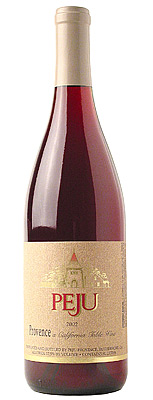 |
|
Wine Details
Price:
$22.00 per bottle
Description:
A proprietary red and white blend of Cabernet Sauvignon, Merlot and Zinfandel (30/16/8) with Chardonnay and French Colombard. This year’s blend consists of approximately 62% Estate red wines, barrel fermented Estate Chardonnay, along with French Colombard from Mendocino County.
|
|
Varietal Definition
Merlot:
Merlot is known as a Noble Bordeaux varietal. Although it came to France in the first century, it was not named until the 1880s. Merlot was originally used only for blending, as it is soft and compliant, very useful in softening other Bordeaux wines like Cabernets. Recently in California and Chile it became popular as a 100% varietal wine. Merlot tends to be easier to grow in a variety of soil conditions and is harvested earlier in the year than Cabernet. Although most Merlots are made to be drunk earlier, there are many with complexities of a Cabernet. Flavors of plum, black cherry, violet, chocolate and orange pair well with rich, red pasta dishes, hearty chicken dishes, and any beef combination that you fancy. The perfect match of course is chocolate. Not only does the chocolate compliment the wine and vice-versa, but the essence of both flavors linger eternally.
|
Cabernet Sauvignon:
Cabernet Sauvignon is the most widely planted and significant among the five dominant varieties in France’s Bordeaux region, as well as the most successful red wine produced in California. Though it was thought to be an ancient variety, recent genetic studies at U.C. Davis have determined that Cabernet Sauvignon is actually the hybrid offspring of Sauvignon Blanc and Cabernet Franc. Cabernet Sauvignon berries are small with black, thick and very tough skin. This toughness makes the grapes fairly resistant to disease and spoilage and able to withstand some autumn rains with little or no damage. It is a mid to late season ripener. These growth characteristics, along with its flavor appeal have made Cabernet Sauvignon one of the most popular red wine varieties worldwide.
|
Zinfandel:
Zinfandel is a variety of red grape planted in over 10 percent of California wine vineyards. DNA fingerprinting revealed that it is genetically equivalent to the Croatian grape Crljenak Kaštelanski, and also the Primitivo variety traditionally grown in the 'heel' of Italy. It is typically made into a robust red wine. Its taste depends on the ripeness of the grapes from which it is made. Red berry fruits like raspberry predominate in wines from cooler areas such as the Napa Valley, whereas blackberry, anise and pepper notes are more common in wines made in warmer areas such as Sonoma County. Many Zinfandels come from head pruned ‘Old Vines’. ‘Old Vine’ is generally understood to mean a vine that is more than 50 years old and that produces less than three tons per acre. ‘Head Pruning’ is an old European style of pruning that trains the vine into the shape of a goblet. It requires no wires or other complex trellis systems. Head pruning spreads the fruit uniformly along the vine and allows light penetration.In the USA a semi-sweet Rosé (blush-style) wine called ‘White Zinfandel’ has achieved widespread popularity. In fact, this popularity has so outstripped all other forms that many fans think there is actually a grape called “White Zinfandel” (there isn’t)!
|
Colombard:
Better known as French Colombard in North America. Acidic grape crushed by some northern Californian producers and made into a fruity white wine of simple character in both dry and sweet versions. Mainly grown in California to provide acidic backbone for white "jug" wine blends. Still grown in France where it is used for white wine blends known as "Bordeaux Blanc" and is also used for distilling into brandy. Also widely grown in South Africa.
|
Chardonnay:
Chardonnay is by far the most widely planted grape crop in California and dominates California’s cooler, coastal, quality wine regions. The natural varietal ‘taste and smell’ of Chardonnay is surprisingly unfamiliar to many wine drinkers, as its true character is often guised with dominating winemaking signatures. Chardonnay’s rather subdued primary fruit characteristics lean toward the crisp fruitiness of apples, pears and lemon, but the variety’s full body is capable of supporting a host of complementary characteristics, such as oak, butter and vanilla. Regardless of what is the appropriate style for Chardonnay, the varietal continues to dominate vineyard plantings in every corner of the world. Close attention to clonal selection has made this broad geographic and climactic range of Chardonnay viable in thoughtful viticultural hands.
|
|